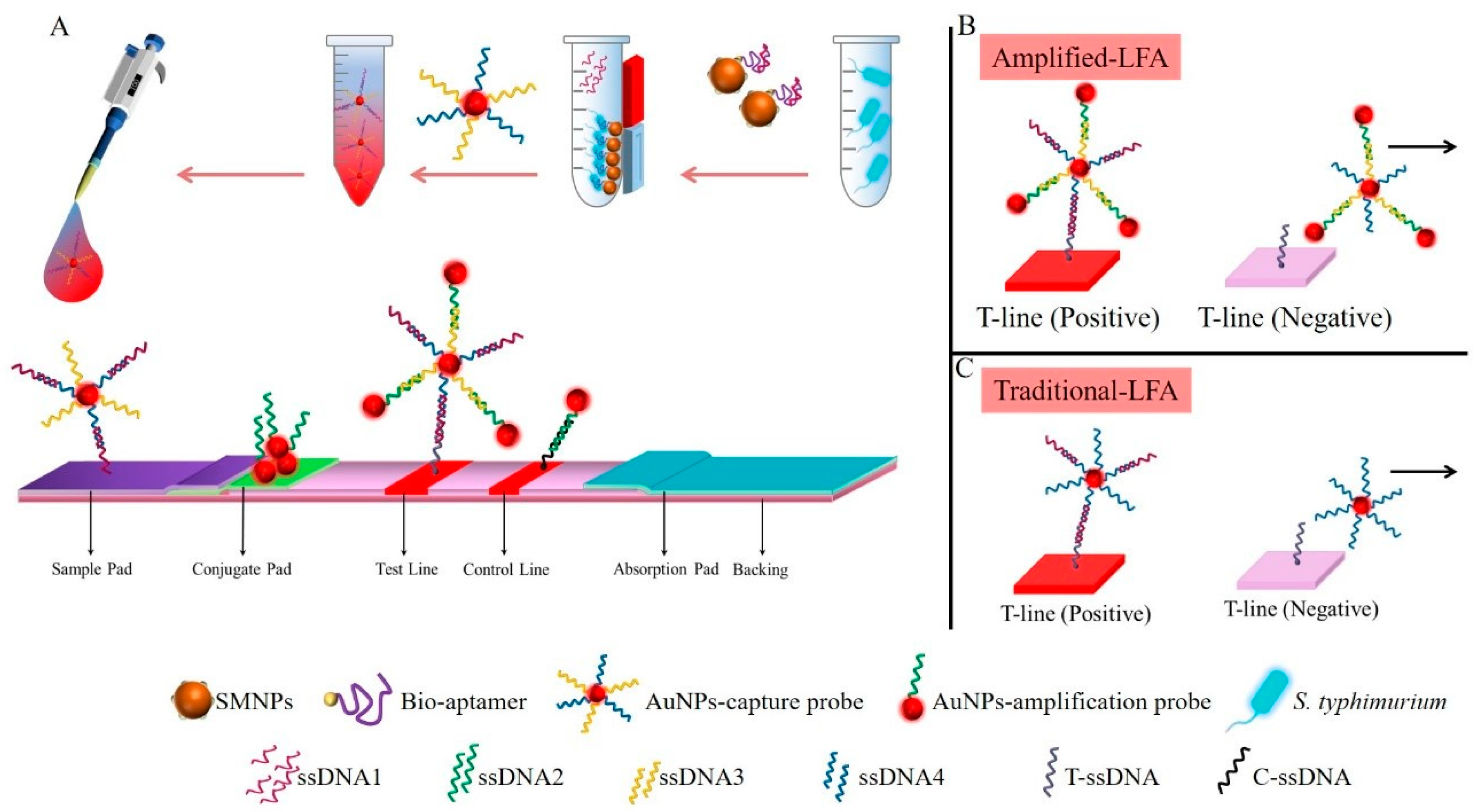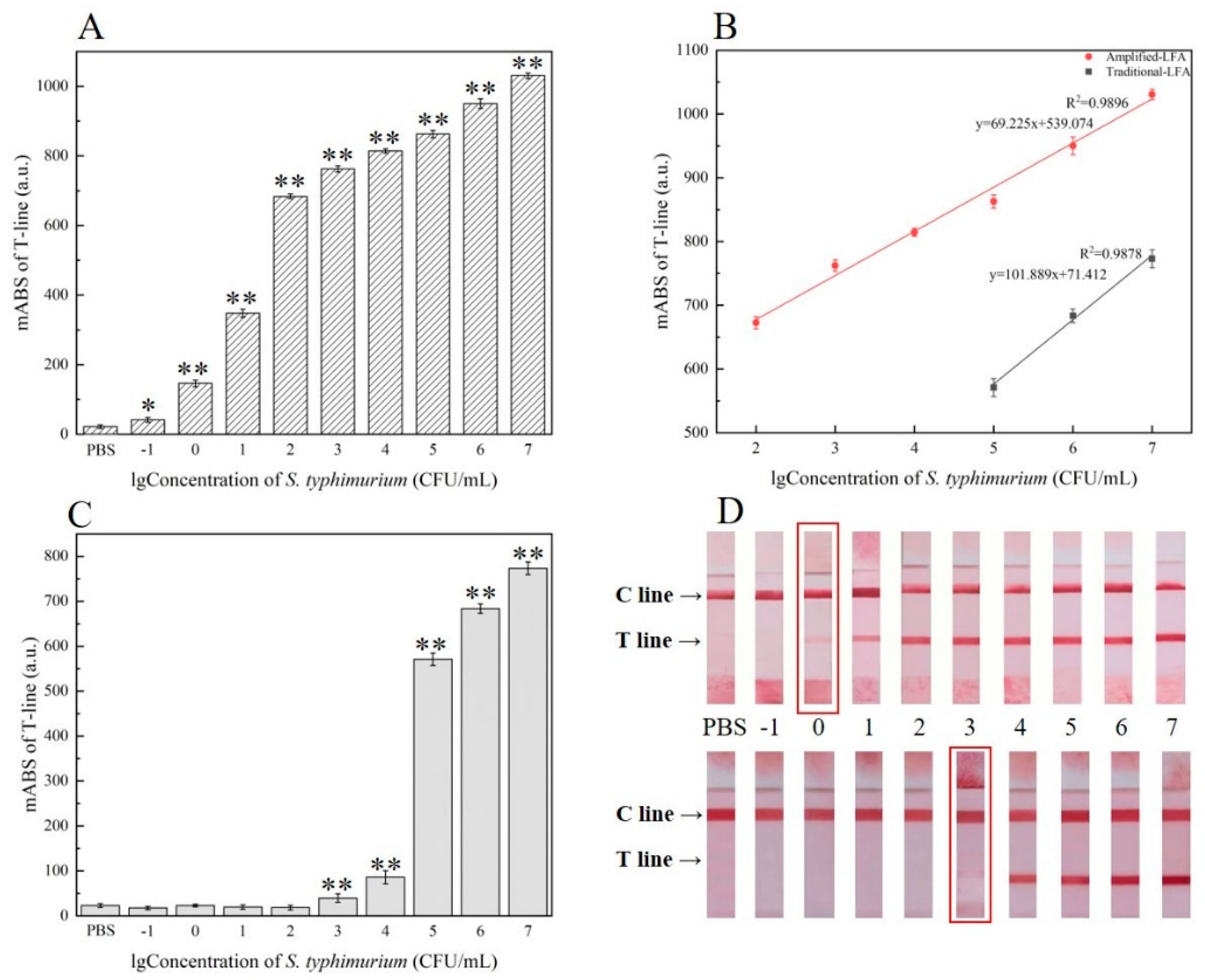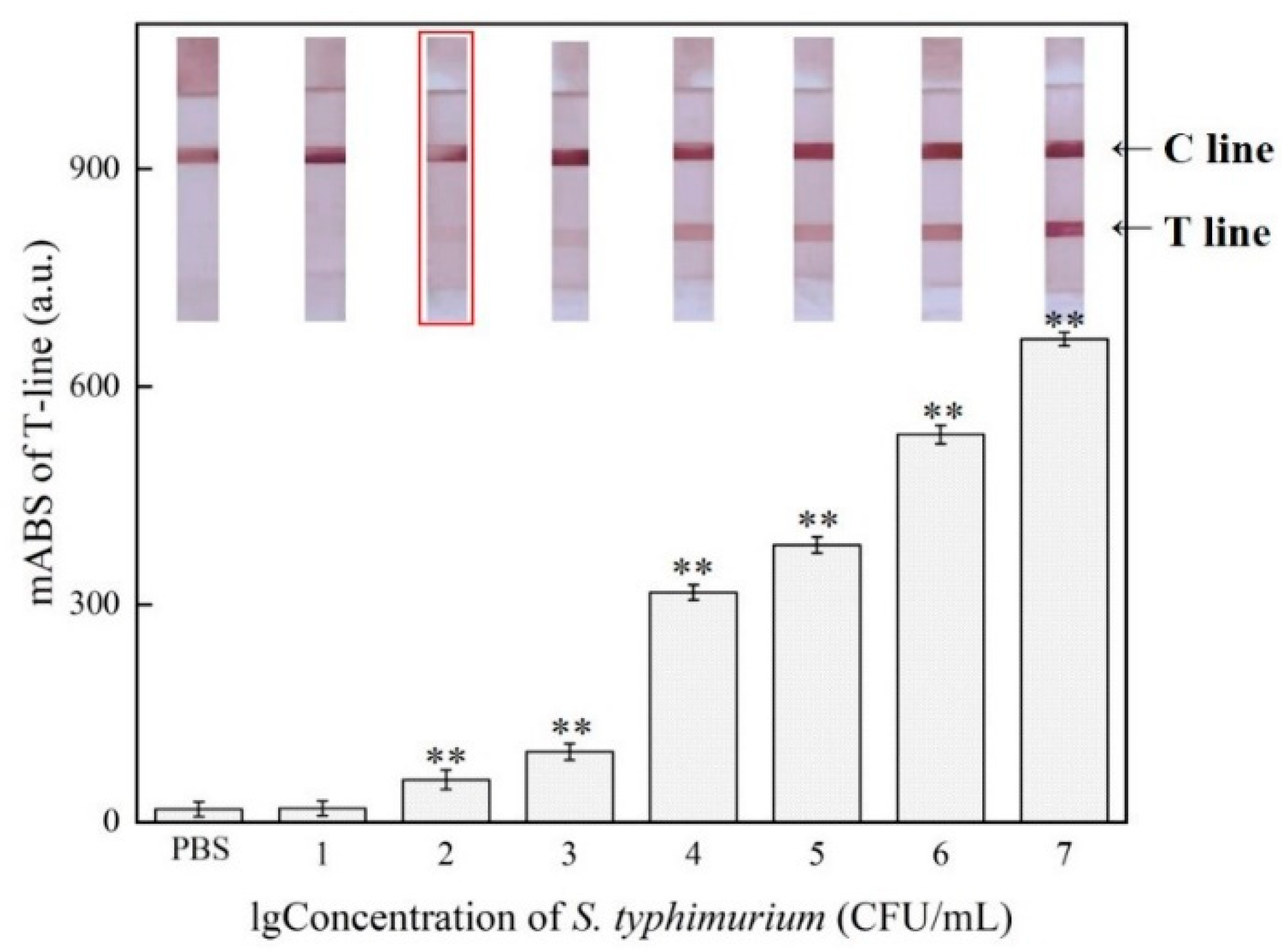An Enhanced Lateral Flow Assay Based on Aptamer–Magnetic Separation and Multifold AuNPs for Ultrasensitive Detection of Salmonella Typhimurium in Milk
Abstract
:1. Introduction
2. Materials and Methods
2.1. Chemicals and Materials
2.2. Equipment
2.3. Bacterial Cultures
2.4. Preparation of SMNPs–Aptamer–ssDNA1
2.5. Magnetic Enrichment of S. Typhimurium
2.6. Preparation of AuNPs–Probe
2.7. Assembly Lateral Flow Assay Test Strips
2.8. Detection of S. Typhimurium in Pure Culture
2.8.1. Detection Sensitivity
2.8.2. Detection Specificity
2.9. Detection of S. Typhimurium in Milk
2.10. Statistical Analysis
3. Results
3.1. The Principle of Enhanced Lateral Flow Assay
3.2. Optimization of Capture Conditions
3.3. Characterization of the AuNPs–Probe
3.4. Optimization of Analysis Parameters for LFA
3.5. Sensitivity of the Lateral Flow Assay
3.6. Specificity of the Enhanced LFA
3.7. Detection in Milk Samples
4. Discussion
5. Conclusions
Author Contributions
Funding
Data Availability Statement
Conflicts of Interest
References
- Wonsawat, W.; Limvongjaroen, S.; Supromma, S.; Panphut, W.; Ruecha, N.; Ratnarathorn, N.; Dungchai, W. A paper-based conductive immunosensor for the determination of Salmonella Typhimurium. Analyst 2020, 145, 4637–4645. [Google Scholar] [CrossRef]
- Liu, R.; Wang, Z.; Liu, X.; Chen, A.; Yang, S. Rapid on-site detection of Salmonella pullorum based on lateral flow nucleic acid assay combined with recombinase polymerase amplification reaction. Poult. Sci. 2020, 99, 7225–7232. [Google Scholar] [CrossRef]
- Esmael, A.; Azab, E.; Gobouri, A.; Nasr-Eldin, M.; Moustafa, M.; Mohamed, S.; Badr, O.; Abdelatty, A. Isolation and Characterization of Two Lytic Bacteriophages Infecting a Multi-Drug Resistant Salmonella Typhimurium and Their Efficacy to Combat Salmonellosis in Ready-to-Use Foods. Microorganisms 2021, 9, 423. [Google Scholar] [CrossRef]
- Zhang, Z.; Liu, D.; Bai, Y.; Cui, Y.; Wang, D.; Shi, X. Identification and characterization of two high affinity aptamers specific for Salmonella Enteritidis. Food Control 2019, 106, 106719. [Google Scholar] [CrossRef]
- Paniel, N.; Noguer, T. Detection of Salmonella in Food Matrices, from Conventional Methods to Recent Aptamer-Sensing Technologies. Foods 2019, 8, 371. [Google Scholar] [CrossRef] [Green Version]
- Spano, S.; Ugalde, J.E.; Galán, J.E. Delivery of a Salmonella Typhi Exotoxin from a Host Intracellular Compartment. Cell Host Microbe 2008, 3, 30–38. [Google Scholar] [CrossRef] [PubMed] [Green Version]
- Wang, L.; Liao, T.; Zhou, H.; Huang, Y.; Chen, P.; Yang, X.; Chen, X. Colorimetric method for Salmonella spp. detection based on peroxidase-like activity of Cu(II)-rGO nanoparticles and PCR. Anal. Biochem. 2021, 615, 114068. [Google Scholar] [CrossRef]
- Du, M.; Li, J.; Zhao, R.; Yang, Y.; Wang, Y.; Ma, K.; Cheng, X.; Wan, Y.; Wu, X. Effective pre-treatment technique based on immune-magnetic separation for rapid detection of trace levels of Salmonella in milk. Food Control 2018, 91, 92–99. [Google Scholar] [CrossRef]
- Pan, R.; Jiang, Y.; Sun, L.; Wang, R.; Zhuang, K.; Zhao, Y.; Wang, H.; Ali, M.A.; Xu, H.; Man, C. Gold nanoparticle-based enhanced lateral flow immunoassay for detection of Cronobacter sakazakii in powdered infant formula. J. Dairy Sci. 2018, 101, 3835–3843. [Google Scholar] [CrossRef] [PubMed] [Green Version]
- Zhao, Y.; Jiang, X.; Qu, Y.; Pan, R.; Pang, X.; Jiang, Y.; Man, C. Salmonella detection in powdered dairy products using a novel molecular tool. J. Dairy Sci. 2017, 100, 3480–3496. [Google Scholar] [CrossRef] [Green Version]
- Bu, T.; Yao, X.; Huang, L.; Dou, L.; Zhao, B.; Yang, B.; Li, T.; Wang, J.; Zhang, D. Dual recognition strategy and magnetic enrichment based lateral flow assay toward Salmonella enteritidis detection. Talanta 2020, 206, 120204. [Google Scholar] [CrossRef]
- Mei, X.; Zhai, X.; Lei, C.; Ye, X.; Kang, Z.; Wu, X.; Xiang, R.; Wang, Y.; Wang, H. Development and application of a visual loop-mediated isothermal amplification combined with lateral flow dipstick (LAMP-LFD) method for rapid detection of Salmonella strains in food samples. Food Control 2019, 104, 9–19. [Google Scholar] [CrossRef]
- Zhou, Y.; Ding, L.; Wu, Y.; Huang, X.; Lai, W.; Xiong, Y. Emerging strategies to develop sensitive AuNP-based ICTS nanosensors. TrAC Trends Anal. Chem. 2019, 112, 147–160. [Google Scholar] [CrossRef]
- Chen, J.; Park, B. Recent Advancements in Nanobioassays and Nanobiosensors for Foodborne Pathogenic Bacteria Detection. J. Food Prot. 2016, 79, 1055–1069. [Google Scholar] [CrossRef]
- Huang, Z.; Liu, Y.; Chen, Y.; Xiong, Q.; Wang, Y.; Duan, H.; Lai, W. Improving the performance of upconversion nanoprobe-based lateral flow immunoassays by supramolecular self-assembly core/shell strategies. Sens. Actuators B Chem. 2020, 318, 128233. [Google Scholar] [CrossRef]
- Wang, J.Y.; Chen, M.H.; Sheng, Z.C.; Liu, D.F.; Wu, S.S.; Lai, W.H. Development of colloidal gold immunochromatographic signal-amplifying system for ultrasensitive detection of Escherichia coli O157:H7 in milk. RSC Adv. 2015, 5, 62300–62305. [Google Scholar] [CrossRef]
- Li, Y.; Chen, X.; Yuan, J.; Leng, Y.; Lai, W.; Huang, X.; Xiong, Y. Integrated gold superparticles into lateral flow immunoassays for the rapid and sensitive detection of Escherichia coli O157:H7 in milk. J. Dairy Sci. 2020, 103, 6940–6949. [Google Scholar] [CrossRef]
- Zhong, Y.; Chen, Y.; Yao, L.; Zhao, D.; Zheng, L.; Liu, G.; Ye, Y.; Chen, W. Gold nanoparticles based lateral flow immunoassay with largely amplified sensitivity for rapid melamine screening. Microchim. Acta 2016, 183, 1989–1994. [Google Scholar] [CrossRef]
- Chen, S.; Yang, X.; Fu, S.; Qin, X.; Yang, T.; Man, C.; Jiang, Y. A novel AuNPs colorimetric sensor for sensitively detecting viable Salmonella typhimurium based on dual aptamers. Food Control 2020, 115, 107281. [Google Scholar] [CrossRef]
- Huang, Y.-M.; Liu, D.-F.; Lai, W.-H.; Xiong, Y.-H.; Yang, W.-C.; Liu, K.; Wang, S.-Y. Rapid Detection of Aflatoxin M1 by Immunochromatography Combined with Enrichment Based on Immunomagnetic Nanobead. Chin. J. Anal. Chem. 2014, 42, 654–659. [Google Scholar] [CrossRef]
- Ondigo, B.N.; Park, G.S.; Ayieko, C.; Nyangahu, D.D.; Wasswa, R.; John, C.C. Comparison of non-magnetic and magnetic beads multiplex assay for assessment of Plasmodium falciparum antibodies. PeerJ 2019, 7, e6120. [Google Scholar] [CrossRef] [Green Version]
- Li, Q.; Qi, H.; Zhong, Z.; Zhou, H.-X.; Deng, C.-Y.; Zhu, H.; Li, J.-F.; Wang, X.-L. A rapid and highly sensitive protocol for the detection of Escherichia coli O157:H7 based on immunochromatography assay combined with the enrichment technique of immunomagnetic nanoparticles. Int. J. Nanomed. 2011, 6, 3033–3039. [Google Scholar] [CrossRef] [Green Version]
- Sharma, A.; Tok, A.; Lee, C.; Ganapathy, R.; Alagappan, P.; Liedberg, B. Magnetic field assisted preconcentration of biomolecules for lateral flow assaying. Sens. Actuators B Chem. 2019, 285, 431–437. [Google Scholar] [CrossRef]
- Joshi, R.; Janagama, H.; Dwivedi, H.P.; Senthil Kumar, T.M.; Jaykus, L.A.; Schefers, J.; Sreevatsan, S. Selection, characterization, and application of DNA aptamers for the capture and detection of Salmonella enterica serovars. Mol. Cell Probes 2009, 23, 20–28. [Google Scholar] [CrossRef] [PubMed]
- Mirkin, C.A.; Letsinger, R.L.; Mucic, R.C.; Storhoff, J.J. A DNA-based method for rationally assembling nanoparticles into macroscopic materials. Nat. Cell Biol. 1996, 382, 607–609. [Google Scholar] [CrossRef] [PubMed]
- Luo, K.; Hu, L.; Guo, Q.; Wu, C.; Wu, S.; Liu, D.; Xiong, Y.; Lai, W. Comparison of 4 label-based immunochromatographic assays for the detection of Escherichia coli O157:H7 in milk. J. Dairy Sci. 2017, 100, 5176–5187. [Google Scholar] [CrossRef] [PubMed]
- Li, X.; Jiang, L.; Zhan, Q.; Qian, J.; He, S. Localized surface plasmon resonance (LSPR) of polyelectrolyte-functionalized gold-nanoparticles for bio-sensing. Colloids Surf. A Physicochem. Eng. Asp. 2009, 332, 172–179. [Google Scholar] [CrossRef]
- Hu, J.; Wang, L.; Li, F.; Han, Y.L.; Lin, M.; Lu, T.J.; Xu, F. Oligonucleotide-linked gold nanoparticle aggregates for enhanced sensitivity in lateral flow assays. Lab Chip 2013, 13, 4352–4357. [Google Scholar] [CrossRef]
- Juewen, L. A simple and sensitive “dipstick” test in serum based on lateral flow separation of aptamer-linked nanostructures. Angew. Chem. 2006, 47, 8123–8127. [Google Scholar]
- Gao, Y.; Deng, X.; Wen, W.; Zhang, X.; Wang, S. Ultrasensitive paper based nucleic acid detection realized by three-dimensional DNA-AuNPs network amplification. Biosens. Bioelectron. 2017, 92, 529–535. [Google Scholar] [CrossRef] [PubMed]
- Chunyan, L. Lateral flow immunochromatographic assay for sensitive pesticide detection by using Fe3O4 nanoparticle aggregates as color reagents. Anal. Chem. 2011, 83, 6778–6784. [Google Scholar]
- Bu, T.; Huang, Q.; Yan, L.; Huang, L.; Zhang, M.; Yang, Q.; Yang, B.; Wang, J.; Zhang, D. Ultra technically-simple and sensitive detection for Salmonella Enteritidis by immunochromatographic assay based on gold growth. Food Control 2018, 84, 536–543. [Google Scholar] [CrossRef]
- Zhao, Y.; Wang, H.; Zhang, P.; Sun, C.; Wang, X.; Wang, X.; Yang, R.; Wang, C.; Zhou, L. Rapid multiplex detection of 10 foodborne pathogens with an up-converting phosphor technology-based 10-channel lateral flow assay. Sci. Rep. 2016, 6, 21342. [Google Scholar] [CrossRef] [PubMed]
- Hu, J.; Jiang, Y.-Z.; Tang, M.; Wu, L.-L.; Xie, H.-Y.; Zhang, Z.-L.; Pang, D.-W. Colorimetric-Fluorescent-Magnetic Nanosphere-Based Multimodal Assay Platform for Salmonella Detection. Anal. Chem. 2019, 91, 1178–1184. [Google Scholar] [CrossRef]
- Hwang, J.; Kwon, D.; Lee, S.; Jeon, S. Detection of Salmonella bacteria in milk using gold-coated magnetic nanoparticle clusters and lateral flow filters. RSC Adv. 2016, 6, 48445–48448. [Google Scholar] [CrossRef]
- Zhang, B.; Yang, X.; Liu, X.; Li, J.; Wang, C.; Wang, S. Polyethyleneimine-interlayered silica-core quantum dot-shell nanocomposites for sensitive detection of Salmonella typhimurium via a lateral flow immunoassay. RSC Adv. 2020, 10, 2483–2489. [Google Scholar] [CrossRef] [Green Version]
- Liu, H.-B.; Du, X.-J.; Zang, Y.-X.; Li, P.; Wang, S. SERS-Based Lateral Flow Strip Biosensor for Simultaneous Detection of Listeria monocytogenes and Salmonella enterica Serotype Enteritidis. J. Agric. Food Chem. 2017, 65, 10290–10299. [Google Scholar] [CrossRef] [PubMed]
- Wu, W.; Zhao, S.; Mao, Y.; Fang, Z.; Lu, X.; Zeng, L. A sensitive lateral flow biosensor for Escherichia coli O157:H7 detection based on aptamer mediated strand displacement amplification. Anal. Chim. Acta 2015, 861, 62–68. [Google Scholar] [CrossRef]
- Shan, S.; Zhong, Z.; Lai, W.; Xiong, Y.; Cui, X.; Liu, D. Immunomagnetic nanobeads based on a streptavidin-biotin system for the highly efficient and specific separation of Listeria monocytogenes. Food Control 2014, 45, 138–142. [Google Scholar] [CrossRef]
- Xiong, Y.; Tu, Z.; Huang, X.; Xie, B.; Xiong, Y.; Xu, Y. Magnetic beads carrying poly(acrylic acid) brushes as “nanobody containers” for immunoaffinity purification of aflatoxin B1 from corn samples. RSC Adv. 2015, 5, 77380–77387. [Google Scholar] [CrossRef]
- Lee, J.-S.; Lytton-Jean, A.; Hurst, S.J.; Mirkin, C.A. Silver Nanoparticle−Oligonucleotide Conjugates Based on DNA with Triple Cyclic Disulfide Moieties. Nano Lett. 2007, 7, 2112–2115. [Google Scholar] [CrossRef] [PubMed] [Green Version]






| Name | Sequence (5′-3′) |
|---|---|
| Bio-aptamer | Biotin-TATGGCGGCGTCACCCGACGGGGACTTGACATTATGACAG |
| ssDNA1 | TAACGTAGGAGGCATATATCAACATAATGTCAAGTCCCCGTCG |
| ssDNA2 | SH-C6-TTTTTTTTTTTTTTTTTTTTTTTTT |
| ssDNA3 | SH-C6-AAAAAAAAAAAAAAAAAAAAAAAAA |
| ssDNA4 | SH-C6-TTGGGACTTGACATTATGACA |
| C-ssDNA | Biotin-AAAAAAAAAAAAAAAAAAAAAAAAA |
| T-ssDNA | TTGATATATGCCTCCTACGTTACCA-Biotin |
| No. | Strain | Source a | Results |
|---|---|---|---|
| 1 | Salmonella Typhimurium | ATCC 14028 | + |
| 2 | Salmonella Typhimurium | CMCC 50222 | + |
| 3 | Salmonella Enteritidis | CICC 21482 | − |
| 4 | Salmonella Dublin | CMCC 50042 | − |
| 5 | Salmonella Dublin | CMCC 50092 | − |
| 6 | Escherichia coli O157:H7 | ATCC 25922 | − |
| 7 | Bacillus cereus | CMCC 63303 | − |
| 8 | Enterobacter aerogenes | ATCC 13048 | − |
| 9 | Cronobacter sakazakii | ATCC 29544 | − |
| 10 | Listeria monocytogenes | ATCC 19112 | − |
| 11 | Listeria welshimeri | ATCC 43550 | − |
| 12 | Staphylococcus aureus | ATCC 13565 | − |
| 13 | Shigella flexneri | CMCC 51572 | − |
| 14 | Vibrio parahaemolyticus | ATCC 17802 | − |
| Method | LOD CFU/mL | Detection Range CFU/mL | Reference |
|---|---|---|---|
| Multifold AuNPs | 4.1 × 102 | 4.1 × 102–4.1 × 107 | this work |
| AuNPs growth | 104 | - | [32] |
| Upconverting phosphor | 104 | 104–107 | [33] |
| Fluorescent–magnetic | 3.75 × 103 | - | [34] |
| Gold-coated magnetic | 103 | 103–106 | [35] |
| Silica-core quantum dot-shell | 5 × 102 | 102–104 | [36] |
| DRS a | 102 | 103–107 | [11] |
| AuMBA@Ag-RPA-SERS b | 27 | 101–106 | [37] |
Publisher’s Note: MDPI stays neutral with regard to jurisdictional claims in published maps and institutional affiliations. |
© 2021 by the authors. Licensee MDPI, Basel, Switzerland. This article is an open access article distributed under the terms and conditions of the Creative Commons Attribution (CC BY) license (https://creativecommons.org/licenses/by/4.0/).
Share and Cite
Gao, P.; Wang, L.; He, Y.; Wang, Y.; Yang, X.; Fu, S.; Qin, X.; Chen, Q.; Man, C.; Jiang, Y. An Enhanced Lateral Flow Assay Based on Aptamer–Magnetic Separation and Multifold AuNPs for Ultrasensitive Detection of Salmonella Typhimurium in Milk. Foods 2021, 10, 1605. https://doi.org/10.3390/foods10071605
Gao P, Wang L, He Y, Wang Y, Yang X, Fu S, Qin X, Chen Q, Man C, Jiang Y. An Enhanced Lateral Flow Assay Based on Aptamer–Magnetic Separation and Multifold AuNPs for Ultrasensitive Detection of Salmonella Typhimurium in Milk. Foods. 2021; 10(7):1605. https://doi.org/10.3390/foods10071605
Chicago/Turabian StyleGao, Pingping, Lihan Wang, Yang He, Yitian Wang, Xinyan Yang, Shiqian Fu, Xue Qin, Qing Chen, Chaoxin Man, and Yujun Jiang. 2021. "An Enhanced Lateral Flow Assay Based on Aptamer–Magnetic Separation and Multifold AuNPs for Ultrasensitive Detection of Salmonella Typhimurium in Milk" Foods 10, no. 7: 1605. https://doi.org/10.3390/foods10071605
APA StyleGao, P., Wang, L., He, Y., Wang, Y., Yang, X., Fu, S., Qin, X., Chen, Q., Man, C., & Jiang, Y. (2021). An Enhanced Lateral Flow Assay Based on Aptamer–Magnetic Separation and Multifold AuNPs for Ultrasensitive Detection of Salmonella Typhimurium in Milk. Foods, 10(7), 1605. https://doi.org/10.3390/foods10071605





